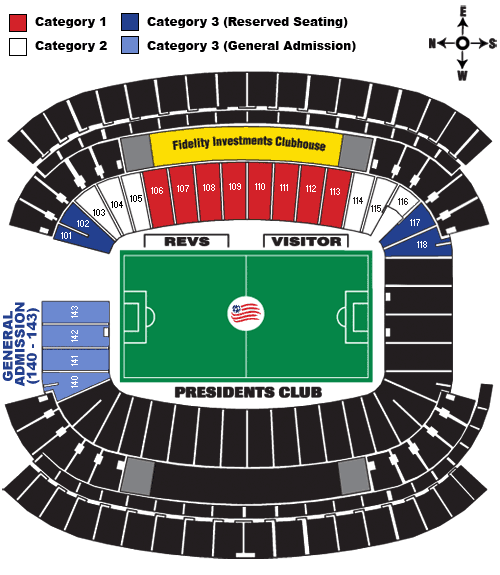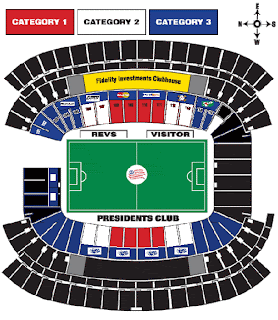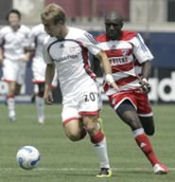
After washing away the sour taste left in my mouth from last night's performance, I decided to get working on the first installment on something I had had planned for the relatively long break the Revs have until their next game: the prospect of a new stadium. I'm not sure how many parts this will have. I plan on covering the various location types, the kind of stadiums that would be right from the various locations, and the pros and cons dealing with the different options. Part 1 will be an overview of the Revolution's situation and the various reasons why they are dragging their feet compared with other MLS franchises.
The New England Revolution are owned by Robert Kraft and are secondary tenants at Gillette Stadium, the home of the NFL's New England Patriots. After failing to secure a location for a new stadium to replace the antiquated Foxboro Stadium in Boston or Rhode Island, Mr. Kraft was very close to moving the Patriots to Hartford, CT. The NFL intervened and convinced him to build a new stadium next to the old one in Foxboro. The total cost of the facility, when it opened in 2002, was in the neighborhood of $325 million dollars. The town of Foxboro would shoulder close to $70 million dollars for infrastructural upgrades, while the rest of the cost was privately financed by the Kraft family and investors. The Krafts also agreed to pay $1 million a year to the town for easement.
The stadium is close to perfect by NFL standards. However, the large stadium isn't conducive to what MLS wants their teams playing in. The league wants all their teams in smaller, soccer dedicated facilities. The designers may have claimed Gillette Stadium was designed with soccer in mind, but other than allowing sufficient space for a pitch, it's hardly ideal for an MLS team. The Revs gameday crowd is only allowed on one side to save costs, any sound generated quickly dissipates in the vast openness, and let's not forget the fieldturf installation that the NFL forced last November. These are just some of the reasons the experience is less than ideal at Gillette and would lead the team and the league towards considering a new home.
Soccer specific stadium (SSS) construction has been the major focus of the league over the last 5+ years. New stadiums in Columbus, LA, Chicago, and Colorado have given those franchises much more control over revenue streams than when they were renting at large football stadiums. These moves have established a stronger economic backbone necessary to grow the league on the field.
The Revs don't have to worry about rent, so a move away from Gillette isn't as urgent. However, 12,000 fans in a close to 70,000 seat stadium isn't the image the league wants to project. So, even though the team isn't bleeding money like the Red Bulls are in New York, there is no immediate pressure being placed on the Krafts to move. In fact, several plans to build stadiums in places like DC, Houston, San Jose, Salt Lake City, and New York keep getting pushed back or scrapped. This is one of the reasons the Revs will be taking a very methodical approach.
There is another reason the Revs are apprehensive to rush in on a stadium deal. The Krafts just began construction of the Patriots Place project next to the stadium in Foxboro.
When completed, it will feature commercial and office space and will include over a dozen restaurants. The new "man mall" will attempt to make the land around the stadium a destination spot of sorts. Before the Revs even think about moving out of Foxboro, the economic impact the soccer gameday crowd has on the new businesses will have to be evaluated. Although that amount of traffic may seem insignificant, it may be the difference in making a profit or going out of business for some of the establishments. Although they sent out feelers to various cities and towns to gage interest last summer, it would take an almost too good to be true situation to get them to move in the short term. The odds of that happening in this area are slim to none.
So what can the team do in the near term to improve the situation at Gillette? Well, one thing they can do is take the current seating arrangement:
And do something similar to what they do at Rice-Eccles in Salt Lake City to actually make a "stadium within a stadium" like this:
The reason why they keep one side closed is twofold. First, they save money because they don't have to staff it or have to clean it up after games. The second is that just opening up the other side would scatter the crowd even more which doesn't help atmosphere. For instance, the crowd for the Celtic friendly last July was over 16,000. However, the entire lower bowl was open and only looked about half full. A crowd of 10,000 would look much worse than it already does.
With the arrangement I have in that second chart, the top 10-15 rows in the Cat I and II sections would be covered with tarps. The normal SSS's have a little over 20 rows. Gillette Stadium has 38 rows. This would improve the atmosphere by concentrating the fans in the bottom 20-25 rows and would give everyone a better sightline. It would also potentially satisfy MLS for the time being if they ever decided to put serious pressure on the team to build a SSS.
This would increase stadium operating costs, but not by a lot if they were smart about it. I'm not a security expert, but they wouldn't have to add twice the security, especially since the total number of seats would only be going up by a few hundred. They would need to have additional eyes and a few more aisle attendants, but the force shouldn't come close to doubling. For concessions, they could keep the built-in stands open and move the smaller stand-alone kiosks to the other side. The additional operating costs could be offset if they sell advertising space on the smaller tarps, especially on the TV side. The non-TV side could have the tarp removed for games they are expecting a large crowd. The ticket cost structure could also be altered with the Cat III seats getting an slight upgrade and they could even create another price range for the midfield seats. This would also allow the groups to be concentrated in corners away from whatever corner they would have the standing section.
This would be a decent solution for the current atmosphere problems. It would also provide better sightlines for most which could raise the number of repeat customers.
That's it for part 1. Future installments will consider possible locations for a new stadium and the kind of features I would like to see in a possible stadium.
You are here: Home > Revs SSS Prospect > Revolution Stadium Prospect - Part 1
Friday, April 20, 2007
Revolution Stadium Prospect - Part 1
Posted by Blue Blooded Journo at 11:47 AM
Revolution
Revs SSS Prospect
Social bookmark this post • View blog reactions
Translate: Portugues | Francais | Espanol | Deutsche | Italiano | Chinese | Korean | Japanese
Subscribe to:
Post Comments (Atom)



















2 Comments:
Cool - this is definitely a series I wanted to see (and definitely have been thinking about myself). I'm looking forward to the rest.
In this theoretical rearrangement of the Razor, where would you put the Midnight Riders section?
Another advantage of your approach is that you could have a family-friendly side of the stadium and a more rowdy side of the stadium.
Post a Comment